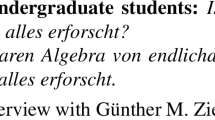Abstract
In this work we study arrangements of k-dimensional subspaces \(V_1,\ldots ,V_n \subset \mathbb {C}^\ell \). Our main result shows that, if every pair \(V_{a},V_b\) of subspaces is contained in a dependent triple (a triple \(V_{a},V_b,V_c\) contained in a 2k-dimensional space), then the entire arrangement must be contained in a subspace whose dimension depends only on k (and not on n). The theorem holds under the assumption that \(V_a \cap V_b = \{0\}\) for every pair (otherwise it is false). This generalizes the Sylvester–Gallai theorem (or Kelly’s theorem for complex numbers), which proves the \(k=1\) case. Our proof also handles arrangements in which we have many pairs (instead of all) appearing in dependent triples, generalizing the quantitative results of Barak et. al. (Proc Natl Acad Sci USA 110(48):19213–19219, 2013). One of the main ingredients in the proof is a strengthening of a theorem of Barthe (Invent Math 134(2):335–361, 1998) (from the \(k=1\) to \(k>1\) case) proving the existence of a linear map that makes the angles between pairs of subspaces large on average. Such a mapping can be found, unless there is an obstruction in the form of a low dimensional subspace intersecting many of the spaces in the arrangement (in which case one can use a different argument to prove the main theorem).
Similar content being viewed by others
Notes
One important difference is that LCC’s give rise to configurations where each point can repeat more than once.
References
Barthe, F.: On a reverse form of the Brascamp–Lieb inequality. Invent. Math. 134(2), 335–361 (1998)
Bennett, J., Carbery, A., Christ, M., Tao, T.: The Brascamp–Lieb inequalities: finiteness, structure and extremals. Geom. Funct. Anal. 17(5), 1343–1415 (2007)
Barak, B., Dvir, Z., Yehudayoff, A., Wigderson, A.: Rank bounds for design matrices with applications to combinatorial geometry and locally correctable codes. In: Proceedings of the Forty-Third Annual ACM Symposium on Theory of Computing, STOC ’11, pp. 519–528 (2011)
Barak, B., Dvir, Z., Wigderson, A., Yehudayoff, A.: Fractional Sylvester–Gallai theorems. Proc. Natl. Acad. Sci. USA 110(48), 19213–19219 (2013)
Borwein, P., Moser, W.O.J.: A survey of Sylvester’s problem and its generalizations. Aequationes Math. 40(1), 111–135 (1990)
Dvir, Z.: On matrix rigidity and locally self-correctable codes. Comput. Complex. 20(2), 367–388 (2011)
Dvir, Z., Saraf, S., Wigderson, A.: Breaking the quadratic barrier for 3-LCC’s over the reals. In: Proceedings of the 46th Annual ACM Symposium on Theory of Computing, STOC ’14, pp. 784–793 (2014)
Dvir, Z., Saraf, S., Wigderson, A.: Improved rank bounds for design matrices and a new proof of Kelly’s theorem. Forum Math. Sigma 2, 10 (2014)
Elkies, N., Pretorius, L.M., Swanepoel, K.J.: Sylvester–Gallai theorems for complex numbers and quaternions. Discrete Comput. Geom. 35(3), 361–373 (2006)
Erdős, P., Bellman, R., Wall, H.S., Singer, J., Thébault, V.: Problems for solution: 4065–4069. Am. Math. Mon. 50(1), 65–66 (1943)
Hansen, S.: A generalization of a theorem of Sylvester on the lines determined by a finite point set. Math. Scand. 16, 175–180 (1965)
Kelly, L.M.: A resolution of the Sylvester–Gallai problem of J.-P. Serre. Discrete Comput. Geom. 1(1), 101–104 (1986)
Lax, P.D.: Linear Algebra and Its Applications. Pure and Applied Mathematics. Wiley-Interscience, New York (2007)
Melchior, E.: Uber vielseite der projektive ebene. Deutsche Math. 5, 461–475 (1940)
Sylvester, J.J.: Mathematical question 11851. Educ. Times 59, 98 (1893)
Author information
Authors and Affiliations
Corresponding author
Additional information
Editor in Charge: János Pach
Rights and permissions
About this article
Cite this article
Dvir, Z., Hu, G. Sylvester–Gallai for Arrangements of Subspaces. Discrete Comput Geom 56, 940–965 (2016). https://doi.org/10.1007/s00454-016-9781-7
Received:
Revised:
Accepted:
Published:
Issue Date:
DOI: https://doi.org/10.1007/s00454-016-9781-7



